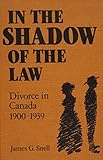In the Shadow of the Law : Divorce in Canada 1900-1939 / James G. Snell.
Material type: TextPublisher: Toronto : University of Toronto Press, [1991]Copyright date: ©1991Description: 1 online resource (322 p.)Content type:
TextPublisher: Toronto : University of Toronto Press, [1991]Copyright date: ©1991Description: 1 online resource (322 p.)Content type: - 9780802058898
- 9781442676060
- 306.89/0971 20
- HQ838 .S63 1991
- online - DeGruyter
| Item type | Current library | Call number | URL | Status | Notes | Barcode | |
|---|---|---|---|---|---|---|---|
 eBook
eBook
|
Biblioteca "Angelicum" Pont. Univ. S.Tommaso d'Aquino Nuvola online | online - DeGruyter (Browse shelf(Opens below)) | Online access | Not for loan (Accesso limitato) | Accesso per gli utenti autorizzati / Access for authorized users | (dgr)9781442676060 |
Browsing Biblioteca "Angelicum" Pont. Univ. S.Tommaso d'Aquino shelves, Shelving location: Nuvola online Close shelf browser (Hides shelf browser)

|

|

|

|

|

|

|
||
| online - DeGruyter Improved Earth : Prairie Space as Modern Artefact, 1869-1944 / | online - DeGruyter In Love with a Handsome Sailor : The Emergence of Gay Identity and the Novels of Pierre Loti / | online - DeGruyter In Search of a Safe Place : Abused Women and Culturally Sensitive Services / | online - DeGruyter In the Shadow of the Law : Divorce in Canada 1900-1939 / | online - DeGruyter In the Grip of Freedom : Law and Modernity in Max Weber / | online - DeGruyter In the National Interest : A Chronicle of the National Film Board of Canada from 1949 to 1989 / | online - DeGruyter In the Shadow of the Mammoth : Italo Svevo and the Emergence of Modernism / |
restricted access online access with authorization star
http://purl.org/coar/access_right/c_16ec
The sanctity of marriage and family life was vvirtually beyond question in the eyes of Canadian society during the early part of the twentieth century. Powerful elements within society had created these values and worked hard to maintain them. Assumptions about the family helped to shape the political, social, economic, and legal structures of Canada. The divoce laws served to maintain the status quo in familial values and gender-based attitudes, enforcing official standards of morality, family structure, and sexual conduct. James G. Snell examines the divorce laws of this period and the efforts of those who contronted the social pressures and challenged the divorce system. In view of the considerable authority of the divorce environment and the broad social support of the stus quo, their efforts are striking. An increasingly assertive group of Canadians, particularly women, defied the social taboos regarding divorce, claiming priority for their own marital needs. They manipulated the Canadian divorce process, taking advantage of existing loopholes in some instances and creating others when necessary. They insisted on the primacy of their own marital problems and in doing so resisted the immediate authority of the divorce environment while at the same time seeking the sanction of that authority. This was true not only for thuse using the formal divorce system, but also for many who resorted to informal processes of divorce.These 'pioneer' divorces led the way in creating a modern Canadian divorce system, based on consensual dissolution of marriage and relying on the courts less for arbitration between contending parties than for endorsement of a privately determined pact.
Mode of access: Internet via World Wide Web.
In English.
Description based on online resource; title from PDF title page (publisher's Web site, viewed 01. Nov 2023)


